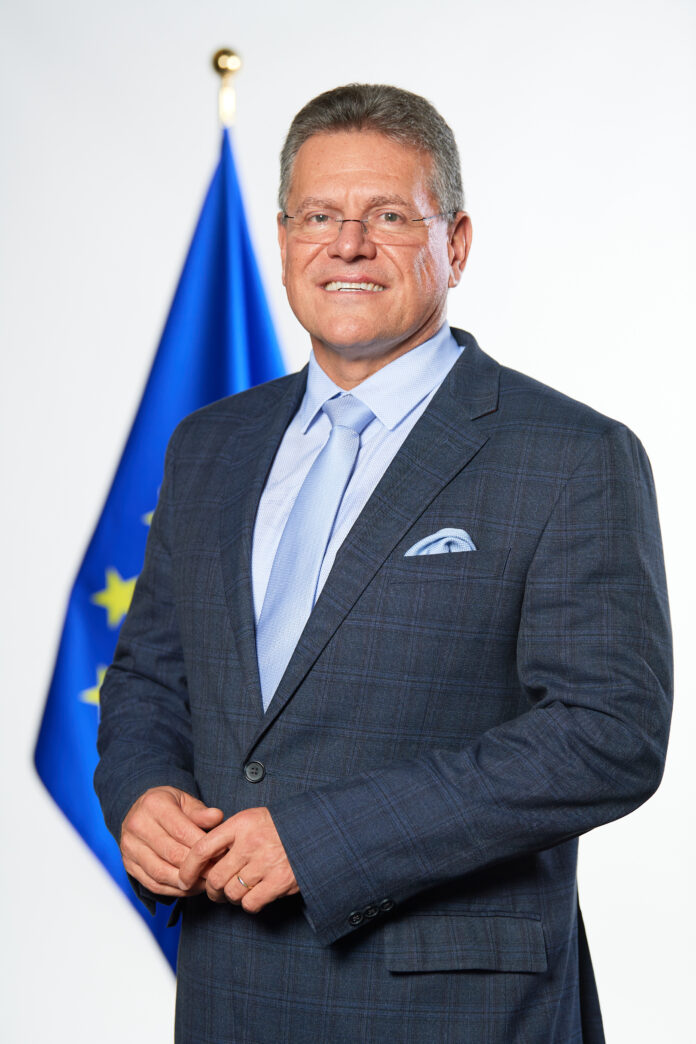
Yesterday, the EU and US finally published a joint statement detailing what EU Commission President Ursula von der Leyen agreed with Trump at the end of July, ending months of uncertainty for EU-US trade. “This is not the end; it’s the beginning. This framework is a first step,” EU Trade Commissioner Maroš Šefcovič (picture) commented.
The document foresees that the U.S. will lower its 27.5 percent tariffs on cars and automotive parts to install a baseline 15 percent US tariff on EU imports, in return for the EU scrapping “tariffs on all U.S. industrial goods,” including its own 10 percent tariff on vehicles. Importantly, the statement also foresees that the EU and the U.S. will “provide mutual recognition on each other’s standards.” This is welcome, as well as the arrangement that the 15% tariff ceiling for the vast majority of products, including pharmaceuticals, is “all-inclusive”, meaning that Trump won’t be able to threaten even higher tariffs, at least not without violating the deal. The U.S. will cap tariffs on European pharmaceuticals, lumber and semiconductors at 15 percent, also regardless of the results of ongoing US investigations. Steel and aluminium imports are still subject to higher tariffs, however.
Today’s EU-US Joint Statement secures the best possible terms for EU companies and consumers:
➡️ the EU is the only partner worldwide with an all-inclusive tariff ceiling
➡️ exclusive guarantee on tariff limit for pharmaceutical and semiconductors sectors
➡️ all-inclusive 15%…— Ursula von der Leyen (@vonderleyen) August 21, 2025
“Mutual recognition” means that the EU cannot introduce stealth protectionism by claiming that US products are unsafe, which is a win for consumer choice in Europe. Unsurprisingly, green NGOs have already started to scaremonger about this, claiming that it would force EU lawmakers to change European standards in order to allow “monster US pick-up trucks” “with far lower safety and air pollution standards” on European roads. If there is one risk that Europeans are not exposed to, it is under-regulation, so it is welcome to see Trump’s trade war at least delivering one positive thing.
In net terms, the deal is obviously negative for the European economy, as for example pharma exports to the U.S. were completely tariff-exempt before Trump’s second term. This may well have serious consequences for prices of medicines on both sides of the Atlantic, and perhaps on employment in the European pharma sector. Europe’s pharma federation thinks that this could cost companies up to 18 billion euro, despite the exemption for generic medicines.
EU-US trade statement targets ‘unjustified’ digital trade barriers https://t.co/WvZWoDH3FV pic.twitter.com/APsJRrN6Bb
— Euractiv (@Euractiv) August 21, 2025
Non-tariff barriers
The EU has also made some rather vague promises to address U.S. concerns regarding EU laws on mandatory sustainability reporting (the Corporate Sustainability Reporting Directive), supply chain oversight (the Corporate Sustainability Due Diligence Directive) and deforestation (the EU Deforestation Regulation). In the joint statement, the EU commits to ensure its rules “do not pose undue restrictions on transatlantic trade” by reducing the administrative burden on businesses in the CSDDD and by proposing changes to the EU’s CSRD and CSDDD directives, something which the EU Commission is doing anyway as part of its “simplification” initiative laid down in its so-called “omnibus package“.
Importantly, when it comes to another new green initiative, the deforestation directive, the EU declares that it recognizes that U.S. commodities production “poses negligible risk to global deforestation.” At the request of the United States, the European Commission already announced in May that it would exempt imports of American products subject to the new European anti-deforestation directive by classifying them as “low risk”. This new deforestation directive imposes all kinds of bureaucratic obligations on trading partners to export products such as cocoa, coffee, soy, palm oil and beef to the EU in order to combat deforestation. The measure not only led to a row with the US. South-East Asian palm oil producers, such as Malaysia and Indonesia, also protested. These governments now consider it unfair that their imports are classified as “standard risk”, as opposed to the US “low risk” classification, especially given that the problem of deforestation in countries such as Malaysia has greatly improved, with a reduction of 13 per cent last year.
In addition, 18 of the 27 EU Member States have demanded further changes to this anti-deforestation directive, which is supposed to come into force in January 2026. According to Reuters, the reason is that some producers simply cannot be expected to meet the conditions, which would also put them at a competitive disadvantage. In other words, the European Union pushed through legislation that is simply unenforceable. Since the directive also applies to exports, governments fear that companies will simply leave the EU as a result.
Importantly, the joint statement also stresses that the European Commission “commits to work to provide additional flexibilities in the CBAM implementation”. CBAM stands for “Carbon Border Adjustment Mechanism”. It is an effective climate tariff which the EU wants to impose on trading partners deemed to not sufficiently copy the EU’s costly climate policies. Turkey, Ukraine and Serbia are estimated to be hit worst, proportionally, by the EU’s new climate tariff, but also poor African economies and India are about to feel the pain. Most certainly, these trading partners will now be emboldened to demand alleviation from this protectionist EU measure, after Trump managed to do so.
EU’s carbon levy could cost Africa $25bn per year, says bank chief https://t.co/PfAuFnWHrw
— Louise Manning (@foodsafetyljm) December 13, 2023
The US will continue to challenge EU digital regulations
The U.S. believes that European digital regulations constitute a “non-tariff barrier” as well. There is some merit to this argument. The Digital Services Act and Digital Markets Act impose numerous new obligations on large digital players, most of which are, of course, American. A US negotiator told the Financial Times: “We continue to address digital trade barriers in discussions with our trading partners and the EU agreed to address these barriers when our first agreement was struck.”
Despite this, the issue was “kept out of the trade negotiations”, according to Šefcovič, who added: “We were focusing on what was very clearly the priority and therefore you won’t find it referenced in the joint statement. (…) Will it come later, will it be discussed? Our relationship is so vast that for sure there will be a lot of issues which will be discussed.”
EU and US agree on ‘framework’ for future trade agreement https://t.co/zLTHlklnsd pic.twitter.com/UYYPUqkWLK
— Euractiv (@Euractiv) August 21, 2025
Furthermore, the joint statement mentions that the EU will not be adopting or maintaining network usage fees, meaning EU telecom companies won’t be able to charge the largest tech platforms for carrying their traffic. the statement also includes a concession that the EU “intends to consult” with the US and US traders on digitalising trade procedures and implementing the EU customs reform, which is currently still being negotiated. Earlier, Trump had already succeeded in getting the European Commission to withdraw a proposal for a digital services tax, which would have been detrimental to American big tech companies but also to European consumers.
A new study by the CCIA Research Centre shows that EU regulations for digital services cost American companies a huge amount of money: up to $97.6 billion per year, with a conservative estimate of $38.9 billion. Do the Eurocrats really think that the U.S. will just accept this? As also Šefcovič has pointed out, a lot will still need to be negotiated, for example getting rid of the new US tariffs on wine and spirits, something EU negotiators failed to avoid. One can be sure the U.S. will not shy away from linking both.
Last but not least, there are EU promises that it “plans to substantially increase procurement of military and defence equipment from the United States”, that it “intends to” procure 750 billion dollar worth of U.S. energy, including liquefied natural gas, oil and nuclear energy products, through 2028, and that it will buy “at least” $40 billion worth of U.S. artificial intelligence chips. These commitments may be lacking much detail, but they can be used as leverage by the U.S. to pressure the EU on the topic of digital regulation.
Conclusion
Given Europe’s strong dependence on the United States for defence in today’s dangerous geopolitical context, it was wise not to allow tensions with Trump escalate over the trade war he started. Transatlantic trade will be more burdened than before Trump’s second term, but things could have turned out worse. Still, as EU Trade Commissioner Maroš Šefcovič pointed out, all of this is merely the “first step.” Negotiations will continue. The EU is reconsidering its regulatory overreach, so scrapping a series of overly burdensome and innovation-hostile green and digital regulations may well kill two birds with one stone: improve trade arrangements with the United States and liberate Europe’s entrepreneurs.












